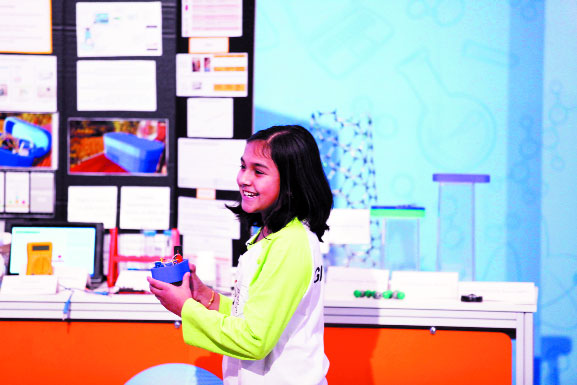Twelve-year-old Gitanjali Rao, an Indian-American scientist, talks about her inspiration and creation with this writer.
She is all of 12 and is known globally as girl wonder for receiving the 2017 Discovery Education 3M Young Scientist Challenge. What catapulted Gitanjali Rao to the high table was her invention, Tethys, a low-cost technology for testing lead in water.
What inspired her to make it? “I was originally inspired by the Flint Water Crisis which I had been introduced through a STEM lab and by watching news. After I learned about Flint, a town in the US, I continued to research and follow it for the next couple of years. When I saw my parents testing for lead in our water, I immediately realised that using test strip would take quite a few tries to get accurate results and I really wanted to do something to change this not only for my parents but for the residents of Flint and places like Flint around the world,” she said.
The Indian American girl has created a sensor-based device that is faster than current technologies available in the market and is cheaper.
“After my testing and developing a method for gathering data for analytics, I intend to partner with the US Environmental Protection Agency to crowd source water quality data. The idea is to not only test local water sources but try to use the data from various sources to produce a heat map that shows the contamination levels in a region in a single view. It can also help in developing in prediction models of the spread in future. Parallelly, I intend to create about 30-50 reproducible prototypes which can be used for field-testing starting with Flint,” Rao said.
For developing the project, she worked with a mentor, Dr. Shafer, who helped her with her experimentation plans and made sure she wasn’t immediately rushing to the next steps. “On the first Skype call, I was a bit nervous to talk to someone so knowledgeable who was an accomplished scientist, but as soon as I started talking to her, she made me very comfortable. I learnt to be diligent and persistent from her. She listened carefully when I narrated my failures to her and provided me with alternate paths to keep moving ahead. She taught me to reach out and ask for help,” said the pre-teen. She added that she earlier hesitated in asking questions but having met Dr. Shafer she’s learnt to reach out to college professors and high school teachers for either space to perform her tests or ask questions related to her research.
She looks up to her parents, who have encouraged her to pursue her ideas with abandon and provide the necessary resources to make them a reality but on the scientific front she looks up to not younger and newer scientists but Marie Curie. “She didn’t just discover two new elements, but also performed life-threatening tests and put others before herself. That is what a true role model means to me,” said she.
Her age is no benchmark to judge her intelligence as concerns like the wage gap among men and women already weigh heavily on her mind. For this too, the young problem solver has a solution. “I wrote a sample bill for the Colorado legislature, proposing that the wage gender gap be closed by giving women the opportunity to stand up and discuss their wages without repercussions from an employer. It is important to say what you believe. If your male co-worker, who is doing the same job as you, for the same amount of time, is getting a higher salary, then speaking up and talking about it is important. We normally don’t do that or aren’t allowed by company policies. I believe that women shouldn’t be prevented to talk to their employer about their salary and share it openly with coworkers. This can help us close the wage gap once and for all,” said Rao.
She has a wise head resting on her small shoulders as she understands the immediacy of the environmental disaster facing us. She has a message for young girls where she says, “I would like to let them know that each one of us can observe around us and understand the social or environmental problems — and find a way to solve them. Do not be afraid to try as failure is part of the learning process. Solving problems does not always have to be about science. If you are worried about marine pollution, create posters to bring awareness and share it. If you think your community needs more recycling bins, approach lawmakers or other influential people by writing or meeting them. There are many ways to solve problems, and technology is just one aspect,” she said.
Writer: Asmita Sarkar
Courtesy: The Pioneer








 OpinionExpress.In
OpinionExpress.In















Comments (0)